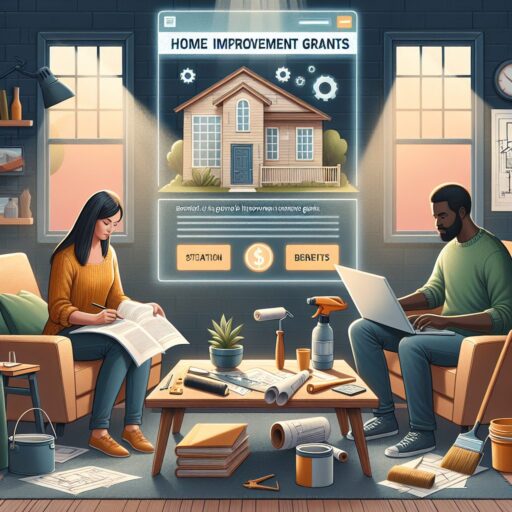Unlocking the Benefits of Home Improvement Grants for Homeowners
Home improvement can be expensive. Many homeowners dream of fixing up their houses but worry about the cost. Did you know there are programs that can help? These programs are called home improvement grants for homeowners. They give money to people who need help repairing or upgrading their homes. You don’t have to pay back this money, which makes it different from a loan. This article will explain what home improvement grants are, who can get them, and how they work.
We will also talk about why these grants exist. Some help families stay safe in their homes. Others focus on saving energy or helping communities look better. By the end of this article, you’ll understand how these grants can make a big difference for homeowners. Let’s dive in!

What Are Home Improvement Grants?
![]()
A home improvement grant is free money given by the government or organizations. It helps people repair or improve their homes. Unlike loans, you don’t have to repay grants. Grants are usually for specific purposes, like fixing roofs or making homes safer.
- Some grants focus on making homes energy-efficient.
- Others are meant to fix dangerous problems, like mold or broken stairs.
- There are even grants to help older adults stay in their homes longer by adding ramps or handrails.
For example, in the United States, the Department of Housing and Urban Development (HUD) offers grants. One popular program is the “HOME Investment Partnerships Program.” It helps low-income families repair their homes.
Grants are often limited to people with lower incomes. But some are open to anyone who needs help. Each grant has its own rules. Knowing these rules is important before applying. Keep reading to learn more about who qualifies for these grants.
Who Can Qualify for Home Improvement Grants?
![]()
Not everyone can get a home improvement grant. Most grants have requirements. These tell you if you qualify or not. Here are some common factors:
- Your income level: Many grants are for low-income families.
- Your location: Some grants only work in certain areas.
- The condition of your house: If your home is unsafe, you might qualify.
- Your age: Older adults and veterans often have special grant options.
For example, let’s say you live in a small town and your roof is leaking. A local government program may offer a grant to help fix it. Or, if you’re over 62 years old, you could apply for the USDA Section 504 Home Repair program.
Statistics show that millions of dollars in grants go unused each year. Why? Because people don’t know about them or think they won’t qualify. It’s worth checking if you meet the requirements. Even if one grant doesn’t work for you, another might.
Types of Home Improvement Grants Available
![]()
There are many types of home improvement grants. Each one serves a different purpose. Here are some common categories:
- Energy Efficiency Grants: These help make homes use less energy. Examples include adding insulation or solar panels.
- Repair Grants: These are for fixing serious problems, like broken plumbing or faulty wiring.
- Accessibility Grants: These help people with disabilities. For example, you can add a wheelchair ramp.
- Community-Based Grants: These improve entire neighborhoods. They might help repaint homes or plant trees.
For instance, the Weatherization Assistance Program (WAP) helps families reduce energy costs. Another example is Habitat for Humanity, which helps rebuild homes for those in need. Knowing which type of grant fits your situation is the first step toward getting help.
These grants can change lives. Imagine a family with no heat during winter. An energy efficiency grant could install a new furnace, keeping them warm and safe.
Steps to Apply for Home Improvement Grants
![]()
Applying for a grant might seem hard, but it isn’t. Follow these steps to increase your chances:
- Step 1: Research grants in your area. Use websites like Benefits.gov or HUD.gov.
- Step 2: Check the eligibility requirements. Make sure you qualify before applying.
- Step 3: Gather documents. You may need proof of income, homeownership, or repairs needed.
- Step 4: Fill out the application carefully. Double-check everything before submitting.
- Step 5: Wait for approval. This can take weeks or months.
It’s helpful to ask questions if you’re confused. Many programs have hotlines or offices where you can get assistance. For example, the Rural Development program under the USDA has agents who guide applicants through the process.
Remember, patience is key. Some grants are very competitive. Even if you don’t get approved the first time, keep trying!
Real-Life Success Stories of Grant Recipients
![]()
Home improvement grants have helped many families. Let’s look at some real-life examples:
- Maria’s Story: Maria, a single mom in Texas, used a grant to replace her home’s old windows. The new windows saved her $500 on energy bills in one year.
- Tom’s Story: Tom, a retired veteran, received a grant to build a wheelchair ramp. Now he can safely enter and leave his home.
- Community Example: A neighborhood in Detroit used a community-based grant to repaint houses and fix sidewalks. The area now looks beautiful, and property values increased.
These stories show how grants can solve problems. They also prove that applying is worth the effort. Whether it’s fixing a small leak or transforming an entire block, grants can make a big impact.
Think about your own home. Could a grant help you too?
Common Challenges When Seeking Grants
![]()
Getting a grant isn’t always easy. Here are some challenges people face:
- Not knowing where to look for grants.
- Confusing applications with lots of paperwork.
- Long waiting times for approval.
- Competition from other applicants.
For example, Sarah, a homeowner in California, applied for an energy grant. She waited six months before hearing back. While she eventually got the grant, the delay was frustrating.
Another challenge is scams. Some companies promise to find grants for a fee but never deliver. Always research carefully and stick to official websites.
Despite these challenges, don’t give up. Many resources are available to help you succeed. Libraries, community centers, and online guides can provide valuable support.
Benefits of Home Improvement Grants
![]()
Why should you apply for a home improvement grant? Here are some benefits:
- You save money by not having to pay for repairs yourself.
- Grants improve safety, like fixing electrical issues or broken stairs.
- Energy-efficient upgrades lower your utility bills.
- Making improvements increases your home’s value.
For example, a study found that energy-efficient homes save homeowners up to 30% on heating and cooling bills. That’s hundreds of dollars every year!
Grants also help communities. When homes look better, neighborhoods feel safer and more welcoming. Everyone benefits when people invest in their homes.
Even if you think your problem is small, a grant could still help. Every little improvement adds up over time.
Conclusion: Why Home Improvement Grants for Homeowners Matter
![]()
Home improvement grants are a great resource for homeowners. They help people fix problems, save money, and make their homes safer. These grants are especially helpful for low-income families, older adults, and people with disabilities.
In this article, we learned what home improvement grants are and who qualifies for them. We talked about different types of grants, from energy efficiency to accessibility. We also explored real-life success stories and discussed the challenges of applying. Finally, we looked at the many benefits these grants bring to individuals and communities.
If you’re a homeowner needing help, consider looking into these grants. They could change your life, just like they’ve changed the lives of others. Start researching today—you might be closer to a safer, better home than you think!
